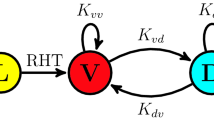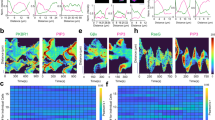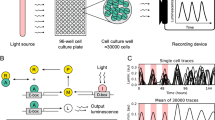Abstract
NJUS et al.1 have recently suggested a membrane model of a biological clock and propose that the clock mechanism is a feedback oscillator in which the ion transport channels envisaged in the fluid mosaic model of cellular membranes2 are involved directly. It is postulated that the proteins which make up these channels respond to changes in concentration gradients of specific ions in the membrane, by grouping to form transport channels when the gradient is small, and dispersing to non-transporting modes when the gradient is large. Thus the protein distribution in the membrane could be regulated by the oscillating ionic gradient and could itself regulate the ionic gradient to complete the feedback pathway and drive the oscillation. It has also been suggested3–5 that oscillatory changes at cellular membranes may be directly associated with the clock mechanism, based on observations that the phase or the period of the oscillation can be changed by treatments which affect the passage of ions through membranes.
This is a preview of subscription content, access via your institution
Access options
Subscribe to this journal
Receive 51 print issues and online access
$199.00 per year
only $3.90 per issue
Buy this article
- Purchase on Springer Link
- Instant access to full article PDF
Prices may be subject to local taxes which are calculated during checkout
Similar content being viewed by others
References
Njus, D., Sulzman, F. M., and Hastings, J. W., Nature, 248, 116–120 (1974).
Singer, S. J., and Nicolson, G. L., Science, 175, 720–731 (1972).
Enright, J. T., Z. Vergl. Physiol., 72, 1–16 (1971).
Bünning, E., and Maser, I., Proc. natn. Acad. Sci. U.S.A., 69, 2732–2733 (1972).
Sweeney, B. M., Pl. Physiol., Lancaster, 53, 337–342 (1974).
Scott, B. I. H., and Gulline, H. F., Aust. J. biol. Sci., 25, 61–76 (1972).
Satter, R. L., Marinoff, P., and Galston, A. W., Pl. Physiol., Lancaster, 50, 235–241 (1972).
Satter, R. L., Geballe, G. T., Applewhite, P. B., and Galston, A. W., J. gen. Physiol., 64, 413–430 (1974).
Hodgkin, A. L., and Huxley, A. F., J. Physiol., 117, 500–544 (1952).
Findlay, G. P., and Hope, A. B., Aust. J. biol. Sci., 17, 400–411 (1964).
Coster, H. G. L., Biophys. J., 5, 669–686 (1965).
Eskin, A., J. comp. Physiol., 80, 353–376 (1972).
Ehret, C. F., and Trucco, E., J. theor. Biol., 15, 240–262 (1967).
Author information
Authors and Affiliations
Rights and permissions
About this article
Cite this article
SCOTT, B., GULLINE, H. Membrane changes in a circadian system. Nature 254, 69–70 (1975). https://doi.org/10.1038/254069a0
Received:
Issue Date:
DOI: https://doi.org/10.1038/254069a0
This article is cited by
-
Phase resetting of the circadian rhythm of carbon dioxide assimilation inBryophyllum leaves in relation to their malate content following brief exposure to high and low temperatures, darkness and 5% carbon dioxide
Planta (1989)
-
Light-promoted changes in apoplastic K+ activity in the Samanea saman pulvinus, monitored with liquid membrane microelectrodes
Planta (1989)
-
The circadian rhythm of carbon-dioxide metabolism in Bryophyllum: the mechanism of phase-shift induction by thermal stimuli
Planta (1983)
-
Effects of cAMP, theophylline, imidazole, and 4-(3,4-dimethoxybenzyl)-2-imidazolidone on the leaf movement rhythm of Trifolium repens?a test of the cAMP-hypothesis of circadian rhythms
Planta (1978)
Comments
By submitting a comment you agree to abide by our Terms and Community Guidelines. If you find something abusive or that does not comply with our terms or guidelines please flag it as inappropriate.



